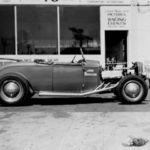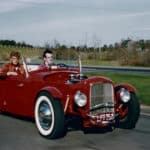In our March 31 story, we showed you a picture of Art McCormic’s light-colored street roadster. For the record, I goofed because I spelled McCormic’s last name wrong and used a K instead of a C. Shame on Me! To make up for the goof we present another picture of the car a year down the road and after it acquired a new paint job (BMC_113). Since Art ran a streamlined track nosed on his ’29 it took the car out of the Roadster class and put it into the streamliner class. A channel job also helped with this decision. We see the car at the October 19th, 1947 S.C.T.A. lakes meet where he ran a speed of 114.21 mph. At this time the lakes were literally jumping with hot cars of all kinds and in Class C which Art ran, we counted 81 timed entered. We did a count and found 44 of them were faster than Art. The car was powered by a ’41 Merc with Weiand heads, Navarro manifold, Winfield cam, and Spalding ignition. If you can get past the two girls on the right, just beyond them is the rear end of Charles “Scotty Muffler” Scott’s customized ‘Model-A. It didn’t matter that the rear quarters were filled and the “beltline” was removed as the body sat on top of the frame rails and qualified the car to run in the Roadster Class. For the record, Scotty ran 100.89 mph that day. We must also thank our pal Bob Morton for the color shot of the two brunettes.
Another reason for starting with a roadster is to do a little setup on “Style”. I like to think the “roadster look” as we know it today was born on the dry lakes. One only has to look at the Elgin Road Races, Legion Ascot and Mines Field to realize that just taking off the fenders didn’t give a roadster “the look”. Big and littles (big rear tires and little front ones), Dago axles, outside (lakes) pipes, channel jobs, belly pans, etc., all these mods were done to make one’s car more efficient and to go faster and we can trace them back to before WWII at Muroc.
What was good on the racetrack was always “cooler” on the street and one could say that Southern California was always way ahead of the game in this ballpark. That is until that “Pete” Petersen guy came along and introduced it to the rest of the country in his groundbreaking new magazine called “Hot Rod”. That’s a good segway into shot two for today, so let’s take a look at the “Grey Whistler” (MTH_120). We’re still trying to confirm the owner’s real name but his ride was a real classic. It’s got the right tire wheel combo to give it just a little “rake” and look at those chromed pipes. And don’t forget the three on a tree so your girlfriend could get real close. Wow! This is also the earliest ride I’ve ever seen running the Thickston “keep your ignition wires dry” covers that were first used on flathead powered boats. Ardun owners, eat your heart out. The location of the shot was Louie Shell’s joint in Santa Monica in mid-’46. As to the Grey Whistler moniker, the car was painted Grey. The whistler part was courtesy of the Deuce Grill shell. At a certain speed, the air rushing through the front insert would cause it to whistle. This was a much sought after item by early builders.
Some of you may have heard of Bill Neumann, he was once the Editor of Rod & Custom Magazine and was also a genuine rodder. Way before he heeded Horace Greeley’s words and moved West, he built one of the best rides ever seen on the Right Coast. NEU-563 is his take on a channeled roadster circa 1954 when he was living in New York. The car has a totally different look than the typical West coast ride of the day thanks to long winters when the owners could super detail everything. Note the unique design he used on the hairpin. Tasty.
Now we can get to the reason I was going on about East Coast Roadsters. Jere Sheehan is our Guru on drag racing up New England way and keeps surprising us with historic goodies so we can try and get the story straight. Early in the week, he had sent us some photos his brother Bob took on a road trip back in 1954. That Road Trip involved a stop at a place called Bonneville that we’ll get to in a minute. But first, there were also some “other” shots in the mix and one of which is our next shot (JSC_069). We see Jere behind the wheel of his ‘33-’34 street rod back about 1957 with his buddy “Muggsy” riding shotgun. They were on their way to the Sanford, Maine dragstrip. Typical of those other coast cars, this one was well finished and super detailed. What’s interesting is the lack of hood and the side panels are molded to the body for a super smooth look. On further investigation, we discovered that the vehicle codes dictated things like fenders and bumpers and such that influenced how the cars were constructed and looked.
Next up is a car from Maryland sitting next to the main drag in downtown Wendover back in 1953 (JSC_067). It was taken on brother Bob’s road trip to the Great White Dyno that year. Again the car is detailed to the max and featured nerf both front and rear. The doors of the Deuce have been molded in and dig those “Hollywood” hubcaps. We’ll see what kind of info we can come up with on the car.
When you’re a turista in car land you have to have your picture taken with a car and Bob did just that all decked out with his rolled cuff Levi’s (JSC_058). We’ll get to the chopped coupe in a second but first, check out the sign to the right. Now have a gander at DOT_723 and you’ll see what sign Bob was standing next to. This pix was taken in ‘64 on the other side of where Bob was standing and shows the sign in the exact same spot. The only thing that’s the same today is what’s left of the hill in the background as a giant Casino stands there now.
Here’s the same chapped coupe that Bob is standing next to in JSC_058 only this time it’s in color and on the salt (DSC_004). Car number 610 is the Class C Comp Coupe and Sedan entry of Lisa-Rossi out of Culver City, CA and powered by a ’53 DeSoto of 290″. The pretty car went on to grace the cover of the October 9, 1953 issue of Motor World but nowhere in the results is a speed for the car listed. Could this possibly be the Tech line the car is waiting in when the picture was taken? Maybe it couldn’t pass tech? Or maybe it blew up on the first pass without getting to the first clock. As a side note, the Lisa-Rossi boys were also known by the name “Spaghetti Benders” and were famous for their drag race exploits. On the left is Doug Rice’s customized ’40 Ford that was entered in Class C Comp Coupe and Sedan but ended up running in C Coupe and Sedan. He ran 126.58 mph for 13th in class. Now for more fun stuff, in the daily results from Tuesday, they have Doug’s car down as car no. 198 instead of the number 663 that it ran. Right behind the Benders, we see a yellow nose that’s featured in our next shot.
JSC_066 shows the Belong Equa Flo Special. That was the name used in the program for this Los Angeles based entry. Starting life as a ’34 Ford the ride had it’s lid lowered and an aerodynamic nose added. To rub a little salt in the competitions wounds the team said nada to a traditional V8 powerplant and picked an engine originally used in Dump Trucks and Military vehicles. Yep, they chose the mighty 302″ GMC inline-6. The car ended up posting a speed of 158.17 mph for a third in class behind first placers Fox-Cobbs at 173.07 mph and the Chrisman Brothers February ‘54 Hot Rod cover car at 163.63 mph.
Here’s another cool road trip shot showing yet more cars waiting in line (JSC_053). Upfront we see Charles Sugden’s Class C Modified Roadster at Bonneville in 1953. Charles came all the way from Salt Lake City with his 286″ 1946 Ford-powered ride to have a go at the existing record. He ran 130.62 mph to finish 13th in class. Along the way, many shots of the slick car were taken and it ended up on the December ’53 Hot Rod and Rod & Custom magazine covers. Behind it on the left is Doug Rice’s Ford Custom again. A 296″ ’42 Merc was under the pancaked hood. On the right, we see the nose of the number 178 Class B Modified Roadster called the Salt Shaker. It was powered by a 259″ ’40 Merc and ran 150.25 mph for a third in class. Lined up behind Rice’s car is the number 628 Class C Roadster called the No Wash Special Numed up behiber 3. It was powered by a 284″ ’48 Merc and turned 119.68 mph for a 20th in class finish.
For the last of the road trip shots, today let’s have a look at JSC_065. The oddball is always welcome and can usually be found at Bonneville. Were looking at the Class D, not the E that’s painted on the side, Modified Roadster that was a pre-entry by Brow-Novi out of Pasadena, California. The engine is a 1936 Cad Flathead V8 displacing 368″. Note the exhaust comes out the top of the block next to the intake ports and the center one is square. We see salt on the body that says it ran but no speeds were recorded in the results. Just a typical Bonneville mystery. Car number 363 in the rear is the Class C Roadster entry of Walt June out of Riverside, California. His ride was powered by a 278″ Merc flathead vintage 1941 and ran a respectable 146.34 mph to take sixth in class. To the left behind the roadster’s ’38 Ford push-car you car barely see the side of a bellytank Lakester. It’s wearing the number 38g the number 38er 38 that indicates it’s the Class B Scotty’s Muffler Shop ride out of San Bernardino (It’s the same Scotty as in shot BMC_113). A 259″ ’48 Ford powered the car to a speed of 196.50 mph for a first in class. Driver Leroy Holmes went on to set a new class record in the car and gain entry into the Bonneville 200 MPH Club with a speed of 201.015 mph.
Meanwhile back to roadsters of a different kind (MAC_018). After WWII every form of motorsports went through tremendous changes almost weekly in the quest of faster speeds and dry lakes racing was one of them. A car that you could once drive to the lakes and remove lights and windshield to run became instantly obsolete as speeds rose. The Outriders were an S.C.T.A. club whose members ran mostly roadsters and felt that pinch. All that changed when the club as a whole vanished from the S.C.T.A. rosters for good after the July ’47 lakes meet. The reason was simple, most were now plying their trade on the dirt tracks of Southern California and getting paid for it instead of spending every last penny on their respective toys for no return. Two of the most famous Outriders were Manuel Ayulo seen in his Merc powered Deuce number 44 and buddy Jack McGrath in his Merc powered T number 16 at Bonelli Stadium in 1946. Ayullo’s Deuce was once his daily driver while McGrath had already lost it’s his big body for a smaller ‘27. Of the 22 California Roadster Association races held in ‘46, Ayulo won six and McGrath won four. It wasn’t long before these two along with their buddies gave up their Outlaw Status and turned Pro ending up at Indy.
Another Roadster guy that made it to the big time was a really young looking Don Freeland who’s seen in Rudy Ramos’s CRA Track Roadster in 1947 (MAC_033). A Deuce chassis with a ‘27 Ford body runs a ‘46 Merc under the hood fitted with Sharp heads and intake and fired by a Spalding ignition. It’s amazing that these guys even survived driving cars without any protection what-so-ever. This is the same car that was featured on the cover of the July ‘48 issue of Hot Rod that was sponsored by Bob Estes. The car was also shoed by the likes of Pat Flaherty, Troy Ruttman (both Indy winners) and Wally Pancratz. Rudy also drove the car at the first post-war S.C.T.A. meet at Rosamond back in ‘45 where he turned 118 mph.
We don’t know how many of you realize that our beloved Roadster name was stolen back in early 1952 and used to describe another form of a racing vehicle. We have to blame a driver who lived up in Fresno and his two crewmen who were former S.C.T.A. racers for the theft. The car that was christened a Roadster was a Kurtis 500A. When Bill Vukovich first sat in the car he told his mechanics, Jim Travers and Frank Coon, that it reminded him of an old roadster and that he felt right at home in it. They ran with it and before you knew it every sportswriter was calling the new look cars Indy Roadsters.
Welcome to Indianapolis in 1956. We see Southern California track roadster graduate Don Freeland again standing next to Bob Estes’ entry for that year’s race during practice. The red and cream Philips built chassis was powered by a 270′ Offy. Don started way down in 26th spot after qualifying at a speed of 141.699 mph and drove a brilliant race to bring the car home in the third spot. He averaged 127.668 mph for the 500 miles. Don also drove the same car in ’54 as number 7 and finished in 6th, and in 55 as car number 12 when he finished in 15th.
I guess we should call this next to last shot a Laydown Roadster (BHC_067). It was the only Kurtis 500H model ever built and showed up at Indy in 1960 as the Ross-Babcock Traveler no. 73 with our roadster buddy Don Freeland behind the wheel. Starting the race in 11th position the car dropped out on the 129th lap with magneto troubles and was classified as finishing in 22nd place. The car was bright lavender with red and yellow so sunglasses were definitely required.
Let’s end the week with we know this isn’t a roadster shot but it is what a roadster morphed into after they became an endangered species back in 1965 when one of those rear-engined cars with a monocoque chassis won the big one at Indy for the first time. Were looking at the driver’s compartment of Scot Dixon’s ride at the 2014 Long Beach Grand Prix, the Target sponsored Chip Ganassi Racing Chevrolet powered Dallara (JMC_4680). Scott qualified the number 9 car in seventh place on the grid. He lead laps 27-28 and 58-77 and completed all 80 race laps to finish way down in 12th place after a stop in the pits. Hey Chip, Scott, anyway I could talk you guys into letting me take a few laps around the circuit? I promise I won’t break anything except maybe the lap record.
















 Ready for some Rest
Ready for some Rest From Dirt to making history at a Ball Park
From Dirt to making history at a Ball Park A Few Questions Answered
A Few Questions Answered The Good, the Bad and more Proboscises
The Good, the Bad and more Proboscises

